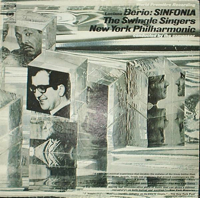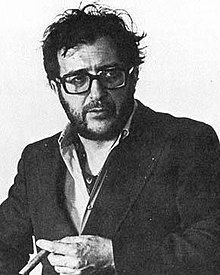
Sylvano Bussotti was an Italian composer of contemporary classical music, also a painter, set and costume designer, opera director and manager, writer and academic teacher. His compositions employ graphic notation, which has often created special problems of interpretation. He was known as a composer for the stage. His first opera was La Passion selon Sade, premiered in Palermo in 1965. Later operas and ballets were premiered at the Teatro Comunale di Firenze, Teatro Lirico di Milano, Teatro Regio di Torino and Piccola Scala di Milano, among others. He was artistic director of La Fenice in Venice, the Puccini Festival and the music section of the Venice Biennale. He taught internationally, for a decade at the Fiesole School of Music. He is regarded as a leading composer of Italy's avantgarde, and a Renaissance man with many talents who combined the arts expressively.

The Swingles are an a cappella vocal group. The Swingle Singers were originally formed in 1962 in Paris under the leadership of Ward Swingle. In 1973, Swingle disbanded the French group, and formed an English group known initially as Swingle II and later as the New Swingle Singers, before settling on the Swingles name.

Catherine Anahid Berberian was an American mezzo-soprano and composer based in Italy. She worked closely with many contemporary avant-garde music composers, including Luciano Berio, Bruno Maderna, John Cage, Henri Pousseur, Sylvano Bussotti, Darius Milhaud, Roman Haubenstock-Ramati, and Igor Stravinsky. She also interpreted works by Claudio Monteverdi, Heitor Villa-Lobos, Kurt Weill, Philipp zu Eulenburg and others. As a recital curator, she presented several vocal genres in a classical context, including arrangements of songs by The Beatles by Louis Andriessen as well as folk songs from several countries and cultures. As a composer, she wrote Stripsody (1966), in which she exploits her vocal technique using comic book sounds (onomatopoeia), and Morsicat(h)y (1969), a composition for the keyboard based on Morse code.
SATB is an initialism that describes the scoring of compositions for choirs or consorts of instruments. The initials are for the voice types: S for soprano, A for alto, T for tenor and B for bass.
Sequenza is the name borne by fourteen compositions for solo instruments or voice by Luciano Berio. The pieces, some of which call for extended techniques, are:

Folk Songs is a song cycle by the Italian composer Luciano Berio composed in 1964. It consists of arrangements of folk music from various countries and other songs, forming "a tribute to the extraordinary artistry" of the American singer Cathy Berberian, a specialist in Berio's music. It is scored for voice, flute, clarinet, harp, viola, cello, and percussion. The composer arranged it for a large orchestra in 1973.
Bernard Rands is a British-American contemporary classical composer. He studied music and English literature at the University of Wales, Bangor, and composition with Pierre Boulez and Bruno Maderna in Darmstadt, Germany, and with Luigi Dallapiccola and Luciano Berio in Milan, Italy. He held residencies at Princeton University, the University of Illinois, and the University of York before emigrating to the United States in 1975; he became a U.S. citizen in 1983. In 1984, Rands's Canti del Sole, premiered by Paul Sperry, Zubin Mehta, and the New York Philharmonic, won the Pulitzer Prize for Music. He has since taught at the University of California, San Diego, the Juilliard School, Yale University, and Boston University. From 1988 to 2005 he taught at Harvard University, where he is Walter Bigelow Rosen Professor of Music Emeritus.

Vinko Globokar is a French-Slovenian avant-garde composer and trombonist.

Sinfonia (Symphony) is a composition by the Italian composer Luciano Berio which was commissioned by the New York Philharmonic for its 125th anniversary. Composed in 1968–69 for orchestra and eight amplified voices, it incorporates musical quotations to represent an abstract and distorted history of culture. The eight voices are not incorporated classically but rather speak, whisper and shout excerpts from texts including Claude Lévi-Strauss' The Raw and the Cooked, Samuel Beckett's novel The Unnamable, instructions from the scores of Gustav Mahler and other writings.
The Paris-based Swingle Singers recorded regularly for Philips in the 1960s and early 1970s and the successor London-based group continued to record, for Columbia / CBS, Virgin Classics and other record labels from 1974 to the present.

Sinfonia is a 1968 Columbia Records recording of Luciano Berio conducting the New York Philharmonic and The Swingle Singers in the premiere of his four-movement "Sinfonia." The composer would later add a fifth movement.

Luciano Berio was an Italian composer noted for his experimental work, and for his pioneering work in electronic music. His early work was influenced by Igor Stravinsky and experiments with serial and electronic techniques, while his later works explore indeterminacy and the use of spoken texts as the basic material for composition.
A–Ronne is a composition by the Italian composer Luciano Berio, composed in June 1974 as a tape composition for 5 actors and arranged in 1975 for unaccompanied vocal ensemble.

Op. 120, No. 1, also entitled Opus 120, No. 1 or in its German form, Opus 120, Nr. 1, is a 1986 arrangement for clarinet and orchestra of Johannes Brahms's Clarinet Sonata Op. 120, No. 1 by Italian composer Luciano Berio. As with the original Sonata, the soloist in this arrangement can either be a clarinet or a viola.

The Modification and Instrumentation of a Famous Hornpipe as a Merry and Altogether Sincere Homage to Uncle Alfred, sometimes shortened to Hornpipe, is an arrangement for six players of Henry Purcell's Hornpipe, from The Fairy-Queen, by Italian composer Luciano Berio. This arrangement was composed in 1969.

Sequenza VII is a composition for solo oboe by Luciano Berio, the seventh of his fourteen Sequenze. The sequenza calls for extended technique. In 1975, Berio used Sequenza VII as part of Chemins IV, which included an orchestra of eleven string instruments. In 1993, Claude Delangle adapted the work for soprano saxophone, naming the revised work Sequenza VIIb.

Coro is a large scale composition for forty voices and forty instruments by Italian composer Luciano Berio.
Sequenza XIV is a 2002 composition for solo cello by Luciano Berio, the last in a series of works for solo instruments Sequenza that he began with the 1958 publication of Sequenza I. The composition for cello was inspired by the expressive and virtuoso playing of cellist Rohan de Saram and features references to traditional Kandyan drumming that he learned as a boy in Sri Lanka.






